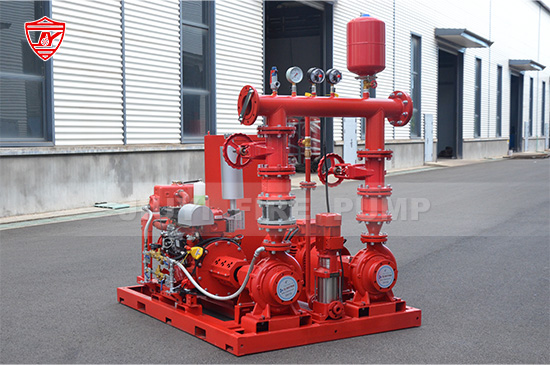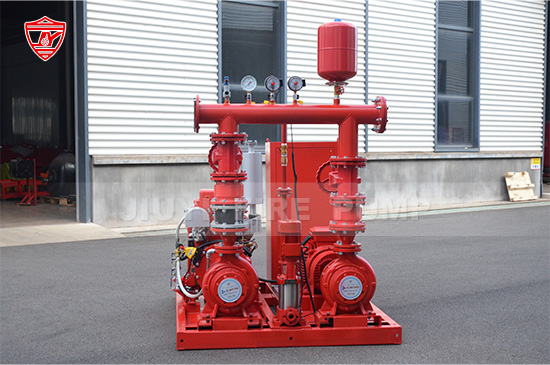n the world of fire protection, every detail matters — and one of the most critical performance metrics for a fire pump is its net pressure. Understanding how to calculate net pressure correctly ensures that your fire pump delivers the required water flow and pressure during emergencies, meeting both NFPA 20 standards and real-world demands.
This article explains what net pressure means, how to calculate it step-by-step, and why it is vital for evaluating and maintaining your fire pump system’s performance.

Net pressure refers to the difference between the discharge pressure and the suction pressure of a fire pump, measured in pounds per square inch (psi) or bar.
It represents the actual energy added by the pump to the water as it moves through the system. In other words, it shows how much pressure the pump itself contributes — not the total pressure at the discharge, which includes incoming suction pressure from the water source.
The fundamental formula is:
Net Pressure = Discharge Pressure – Suction Pressure
For example:
If the discharge pressure is 140 psi and the suction pressure is 20 psi, then:
Net Pressure = 140 – 20 = 120 psi
This means the pump adds 120 psi of energy to the water flow.
The net pressure determines whether a fire pump can meet the system’s design requirements. When net pressure is too low, the fire protection system may fail to deliver sufficient water to sprinklers or hydrants. When it is too high, system components may be exposed to unnecessary stress or potential damage.
Performance Evaluation:
It helps confirm that the pump is operating at its rated capacity and in accordance with NFPA 20.
System Design Verification:
Designers use net pressure to ensure the fire pump can overcome friction losses, elevation head, and other resistances in the system.
Testing and Commissioning:
During acceptance or annual flow testing, calculating net pressure verifies whether the pump is performing as expected.
Troubleshooting:
A sudden change in net pressure may indicate suction issues, impeller wear, or valve obstructions.
To accurately calculate net pressure, it’s essential to understand the two main pressure readings involved:
This is the pressure of the water entering the fire pump. It depends on the source — for example:
From a municipal supply (positive suction)
From a storage tank (static suction head)
From a suction lift (negative pressure if the pump is above the water source)
This is the pressure measured at the pump discharge flange. It represents the total pressure available to the fire protection system before losses in piping and valves.
Net pressure always corresponds to a particular flow rate. Fire pump performance curves are developed based on flow (GPM or L/min) versus pressure (psi or bar).
Let’s go through a simple step-by-step method for calculating net pressure in practice.
Install pressure gauges at both the suction and discharge sides of the pump. These should be located as close to the pump flanges as possible to reduce measurement errors.
Operate the pump under different flow conditions — 0%, 100%, 150% of rated flow — as specified by NFPA 20. For each flow, record both suction and discharge pressures.
Subtract the suction pressure from the discharge pressure:
Net Pressure = Discharge Pressure – Suction Pressure
The calculated net pressure at each flow condition should match or be within the tolerance of the manufacturer’s certified performance curve. Deviations may indicate performance degradation or incorrect installation.
Suppose you have a UL-listed fire pump rated at 1000 GPM @ 120 psi. During a field performance test, the following readings are recorded:
| Flow (GPM) | Suction Pressure (psi) | Discharge Pressure (psi) | Net Pressure (psi) |
|---|---|---|---|
| 0% (Churn) | 40 | 170 | 130 |
| 100% | 35 | 155 | 120 |
| 150% | 30 | 135 | 105 |
From this data, you can see that at 100% rated flow, the net pressure = 155 – 35 = 120 psi, which matches the pump’s rated pressure. This confirms proper performance.
Several variables can influence the actual net pressure observed during testing or operation. Understanding these factors helps engineers and operators maintain accurate system performance.
Fluctuations in water source pressure (municipal or tank) can significantly affect suction pressure, and therefore net pressure.
If the pump or discharge outlet is located at a higher or lower elevation than the water source, the static head or lift will alter suction pressure readings.
Piping, fittings, valves, and strainers introduce friction losses that impact both suction and discharge pressure.
Over time, impeller erosion or wear reduces the pump’s ability to add energy to the water, decreasing net pressure.
Entrained air or cavitation in the suction line can distort pressure readings and damage the pump, resulting in inaccurate or unstable net pressure.
The NFPA 20 Standard for the Installation of Stationary Pumps for Fire Protection sets specific criteria for fire pump testing and performance measurement.
The pump must deliver its rated flow and net pressure as per the manufacturer’s certified curve.
At 150% of rated flow, the net pressure should not drop below 65% of rated pressure.
The test results must be documented and compared against manufacturer data to verify compliance.
Understanding and following these requirements ensures that your fire pump system performs reliably under emergency conditions.
Even experienced operators can make mistakes when testing or calculating fire pump net pressure. Avoid these common pitfalls:
Incorrect Gauge Location:
Placing gauges too far from the pump flanges introduces errors due to friction losses.
Uncalibrated Gauges:
Always use calibrated, accurate gauges to avoid false readings.
Ignoring Elevation Head:
If the suction or discharge gauge is not at the same elevation as the pump centerline, adjustments must be made for static head differences.
Not Recording Flow Rate:
Net pressure without a corresponding flow rate is meaningless — both must be measured together.
Skipping Temperature or Viscosity Effects:
While water temperature has minimal effect in fire systems, extremely cold or hot conditions can slightly alter pressure readings.
Bleed air from pressure gauges before testing.
Record readings slowly and steadily at each flow rate.
Compare results with historical test data to identify trends.
Inspect strainers and valves for obstructions that could affect suction pressure.
Conduct annual flow tests as required by NFPA 25 to verify ongoing performance.

Calculating net pressure is a fundamental part of fire pump testing, commissioning, and maintenance. It reveals how effectively the pump converts mechanical energy into hydraulic energy — ensuring that the fire protection system will perform when needed most.
By understanding how to measure, calculate, and interpret net pressure accurately, engineers and fire safety professionals can maintain reliable fire protection systems that comply with NFPA 20 and deliver dependable performance in critical situations.
Whether you are installing a new system or verifying an existing one, mastering net pressure calculation is essential to keeping lives and property safe.